The dogs had Sarah up bright and early, as usual, and as I was still slumbering Sarah took the dogs for a walk into Albalate del Arzobispo, which turned out to have a lovely Mudejar* style church and a castle. I ambled along the river adjacent to our aire later to have a look from afar, but the photos are courtesy of Sarah.
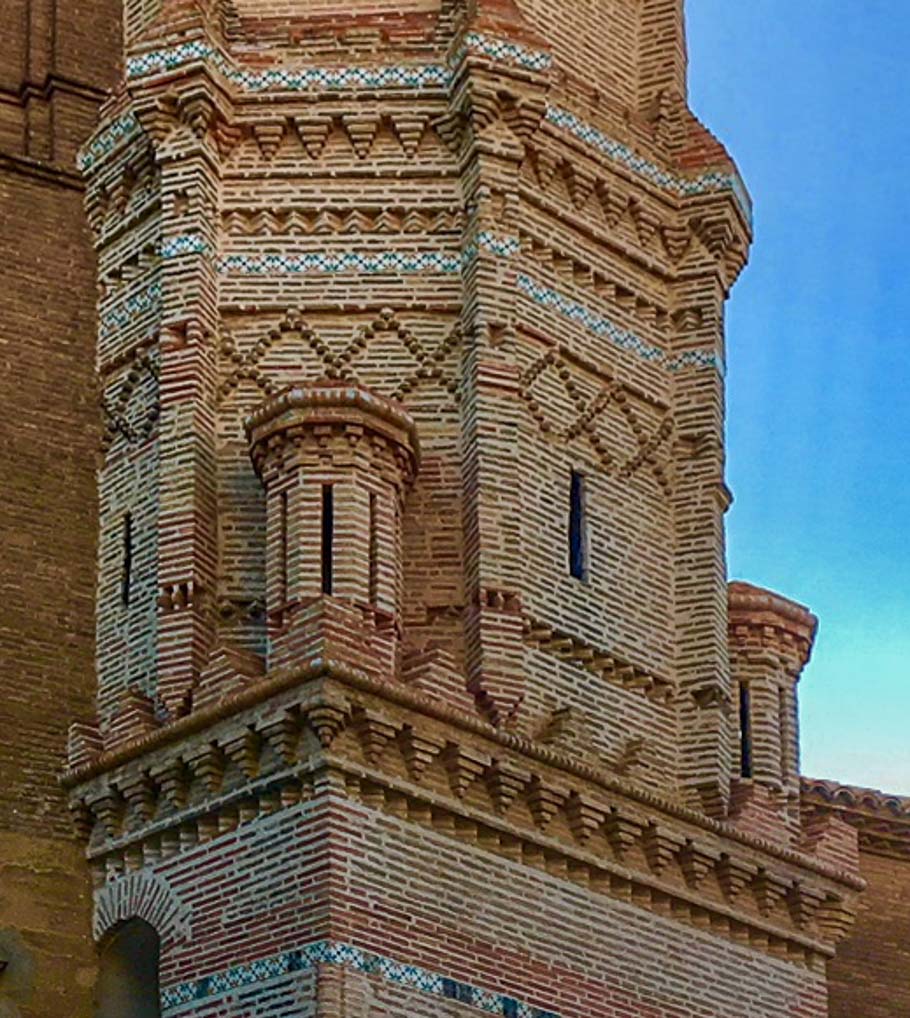
Mudejar Church at Albalate del Arzobispo

Mudejar church at Albalate del Arzobispo
Our main target today was Spain’s fifth biggest city Zaragoza. You may recall a day or two ago that I mentioned planning to visit a town that had been destroyed in the Spanish Civil War. We had abandoned that plan, but purely by luck our journey to Zaragoza took right past Belchite, the town in question. When I had heard about Belchite I had assumed it had been destroyed by some atrocity committed by Franco’s fascists, because as a good Western liberal that is the general story I have been taught by Picasso, George Orwell and others. In fact Belchite, it turns out, was destroyed mainly by the artillery and weapons of the Republicans (the good guys) in an attack carried out agains the fascists in 1937.
Enough history. As I have explained in a previous blog, Belchite can only be visited with a Spanish guide. We didn’t have time for that, but we found that at one end of the town we could get very close without actually entering the ruins. There was a very beautiful example of a Mudejar church, which had clearly been hit by large calibre weapons a number of times. After a necessarily brief viewing we moved on.
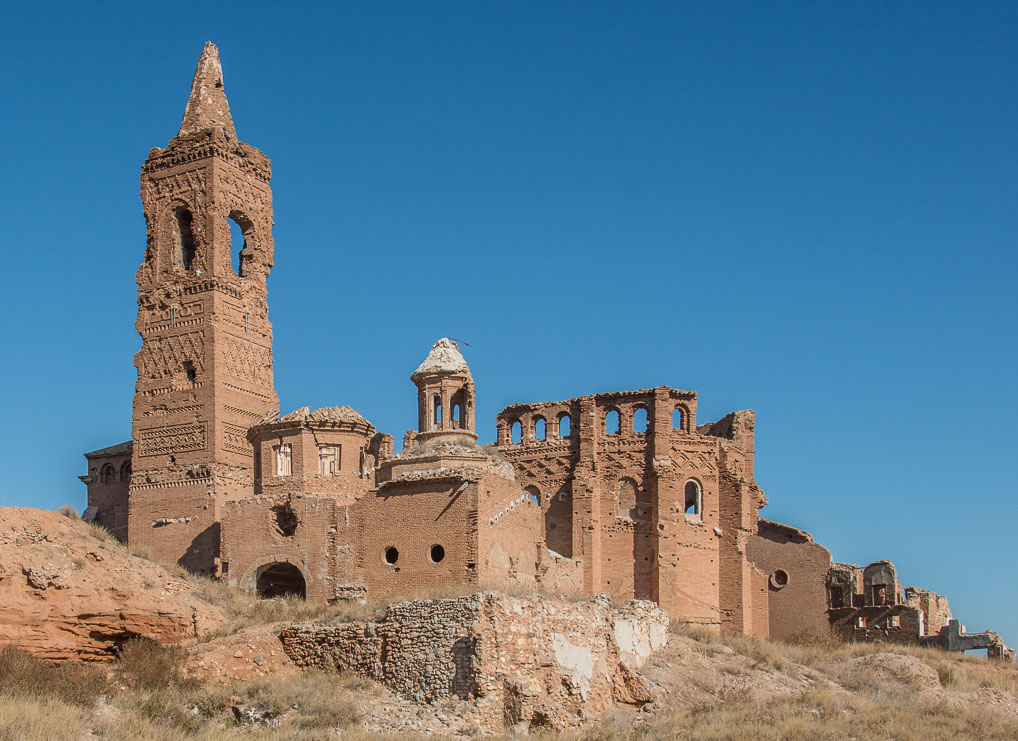
Shelled church at Belchite
The landscape around Belchite was extremely odd. Barren, like much of Central Spain at this time of year, but with strangely shaped hillocks, that looked almost lunar in their appearance.

Lunar Landscape
As we have travelled around Spain nearly every town and various electricity pylons, despite the electricity company’s best deterrents, have been covered with Stork’s nests. We know from visiting towns in Spain in the summer that many places are filled with the noise of Stork’s clattering beaks. During this trip, all the nests have been empty because all good Storks should have migrated to Africa for the winter. On our journey to Zaragoza, however, we saw one poor stork standing in his nest all alone. I can only surmise that for some reason it was a youngster who had failed to follow his parents. It looked in good condition and was not apparently injured. Whether it stands a chance in a Spanish winter I have no idea, but if it does it is going to be very lonely until next spring.
We finally reached Zaragoza and headed for the best parking I had identified from my apps. Unfortunately this meant manoeuvring Basil through small streets with cars on either side. At times Sarah had to lean out of her window to ensure I wasn’t clipping anyone’s wing mirrors. The fact that cars were parked in every available space did not give us much hope of finding anywhere for Basil and when we finally reached the car park I had identified it was, of course, full to overflowing.
Having seen how busy the parking situation seemed to be everywhere we decided to give up on Zaragoza and headed for a LIDL (you know it makes sense) to pick up some bread for lunch. As luck would have it the one way road leading out of LIDL spat us out onto a road parallel to Zaragoza’s River Ebro. We could see the main Cathedral was not that far away and there were places to park everywhere. Initially we were suspicious that for some reason parking was not legal in that area, but we stopped and looked around and could see no signs indicating parking was not allowed. We concluded that Zaragozan’s (if that’s the right word for a person from Zaragoza) were obviously too lazy to walk 10 minutes to work in the morning.

Zarogoza’s old bridge with Basilica de Neuestra Senora del Pilar in the background
The stroll along the river to the centre of Zaragoza was pleasant in its own right. We headed for the enormous Plaza in the centre. It’s one of the biggest squares we have ever seen. At one end is the old Cathedral of the city, which is a mixture of styles, ranging from Mudejar to Gothic. Next to this is a Rennaisance period Exchange building modelled from similar structures in Florence. In the middle is one of the largest Cathedrals I have ever seen. This is the Basilica de Neuestra Senora del Pilar (Cathedral of Our Lady of the Pillar).
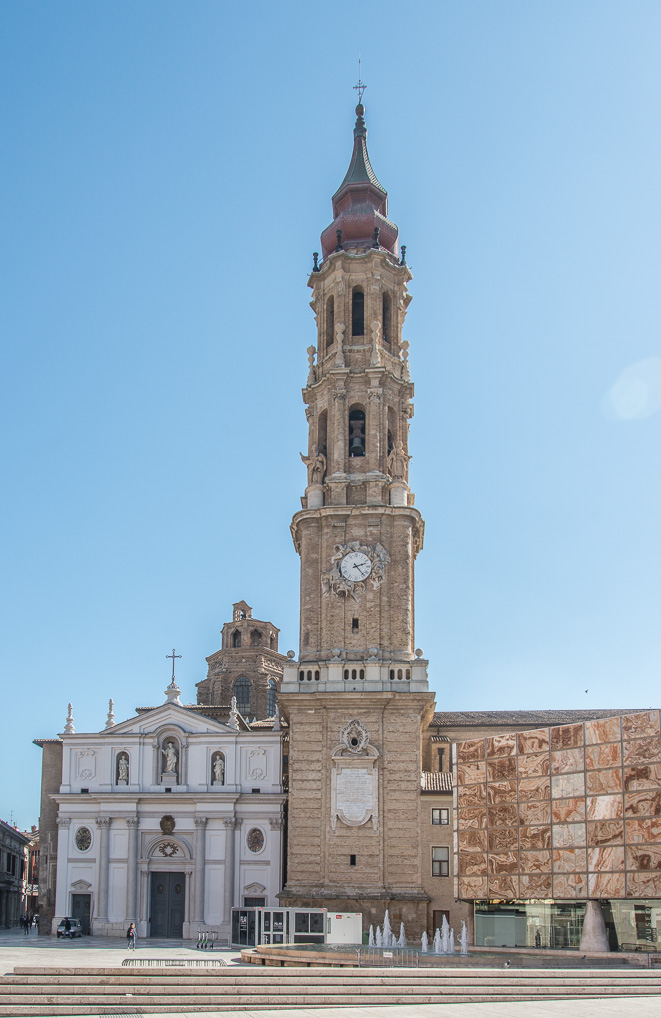
The Old Cathedral of Zaragoza
This Cathedral is apparently the holiest spot in Spain. The story behind it is mystifying in the extreme. I’ve read and re-read about it on Wikipedia and I’m still not sure I full understand the theology. I’ll start with the word “apparently”, which you will need to apply in your minds throughout this explanation. In AD40 St. James the Apostle (he of Santiago de Compostella fame and brother of Jesus) happened to be standing in Zaragoza when he saw an apparition of the Virgin Mary. So far so clear. The Angels who had carried Mary had, on the journey, carved a wooden statue of Mary which they gave to St. James on a marble pillar. A church was built around this statue – which is seen by the Papacy and the devout, as an actual incarnation of the Virgin. The church has been rebuilt and rebuilt until the current enormous version was constructed in the 18thcentury. I think we better gloss over the bit about the church and the (original??) statue being destroyed by a fire in the 15thCentury and scholars thinking that the statue was actually carved in that century.

Basilica de Neuestra Senora del Pilar
Having vaguely grasped the concepts we both visited the interior, about which I can say little positive except it is BIG. The statue is housed under a huge canopy containing seats for visitors to pray to the Virgin. There were many such people, some praying out loud and so I felt taking a photo would be intrusive. At the back of the shrine there is a small section cut out of the wall exposing a section of the marble pillar, where numerous devotees were kneeling, one at a time, on a well worn step and kissing the pillar through a sort of gold collar.
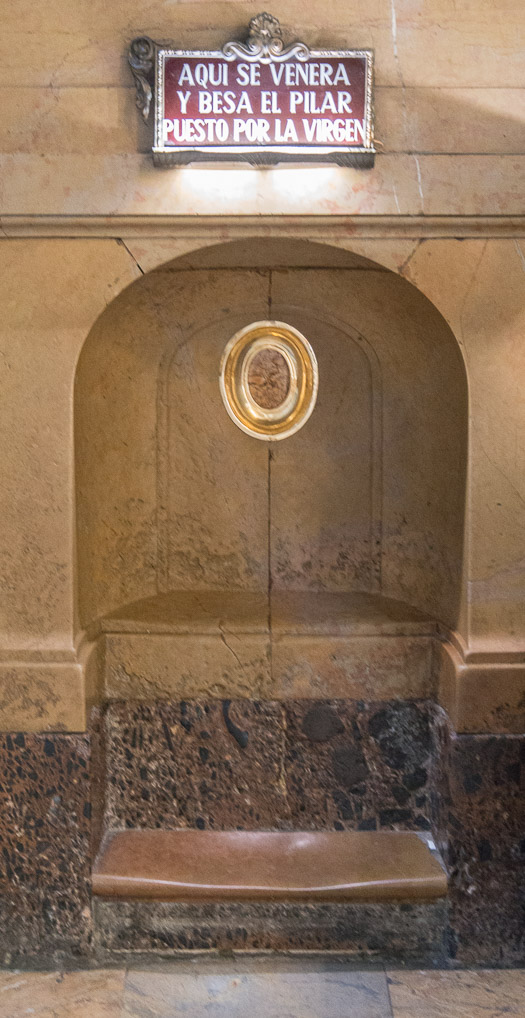
This is where you can kiss the “pillar” – through the little gold collar.
As I understand it the Vatican has canonised the statue and the pillar, which I think makes them a Saint, with the result that there are several other churches in Spain and dozens in South America dedicated Our Lady of the Pillar.
It all makes me realise where Martin Luther was coming from! Oh, and by the way, you get seven years off your time in Purgatory for a visit – thank goodness we managed to find somewhere to park.
Back out in the square we found the most enormous pyramid of flowers which were the result of Zaragoza’s biggest annual festival, which takes place on 12thOctober. It won’t take a great leap of your imagination to guess that 12thOctober was when Our Lady appeared to Saint James, or that the pyramid of flowers was topped by a replica of the holy statue.
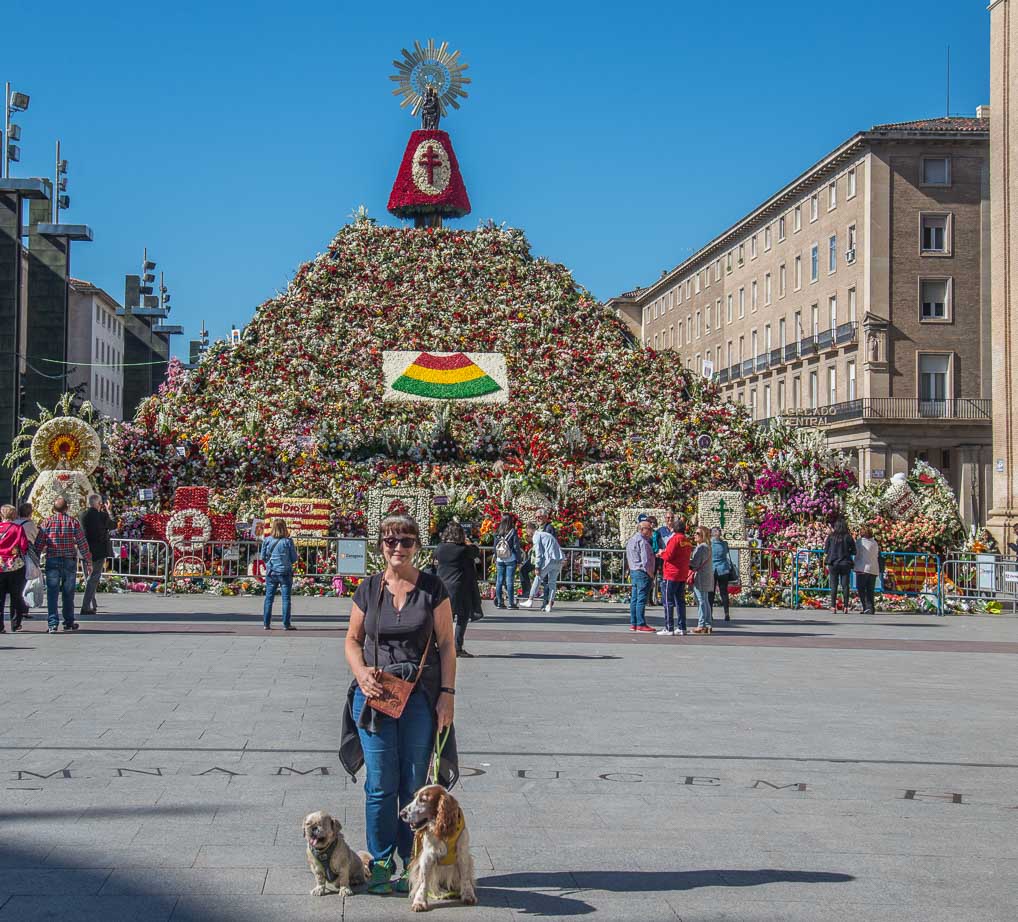
Sarah with the pyramid of flowers
Despite all my cynicism about the pillar business, Zaragoza’s main square is visually stunning as indeed is the outside of the Cathedral. For people unencumbered by dogs Zaragoza has some good Roman remains, which are all housed within museums and it is also the home city of Goya and there are good examples of his work in several galleries around the city.
After leaving Zaragoza we have made our way north to a free aire (42.135334, -0.420177) in the town of Huesca. Tomorrow we head into the Pyrenees, but we may have time in the morning to have a quick look round Huesca’s old town, if Sarah hasn’t done it all with the dogs before I get up!
*Mudejar style architecture, which I think is unique to Spain, is Christian architecture influenced by muslim designs after the re-conquest of Spain. Often the builders themselves were muslims or muslim converts.
